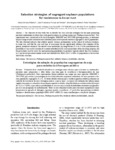Please use this identifier to cite or link to this item:
http://www.alice.cnptia.embrapa.br/alice/handle/doc/658106| Title: | Selection strategies of segregant soybean populations for resistance to Asian rust. |
| Authors: | RIBEIRO, A. S.  TOLEDO, J. F. F. de   RAMALHO, M. A. P.   |
| Affiliation: | ALINY SIMONY RIBEIRO, UFL; JOSE FRANCISCO FERRAZ DE TOLEDO, CNPSo; MAGNO ANTONIO PATTO RAMALHO, UFL. |
| Date Issued: | 2009 |
| Citation: | Pesquisa Agropecuária Brasileira, Brasília, DF, v. 44, n. 11, p. 1452-1459, nov. 2009. |
| Description: | The objective of this work was to identify the best selection strategies for the more promising parental combinations to obtain lines with good resistance to soybean Asian rust (Phakopsora pachyrhizi). Two experiments were carried out in the field during the 2006/2007 and 2007/2008 growing seasons, to determine the percentage of infected leaf area of individual plants offive parents and their segregant F2 and F3 populations. The data obtained indicates that additive genetic variance predominates in the control of soybean resistance to Asian rust, and that the year and time of assessment do not significantly inftuence the estimates of the genetic parameters obtained. The narrow-sense heritability (h~ ranged from 23.12 to 55.83%, and indicates the possibility of successful selection of resistant individuais in the early generations of the breeding programo Ali the procedures used to select the most promising populations to generate superior inbred lines for resistance to P pachyrhizi presented similar results and identified the BRO1-18437 x BRS 232 population as the best for inbred line selection. |
| Thesagro: | Glycine Max Phakopsora Pachyrhizi Seleção |
| NAL Thesaurus: | heritability |
| Keywords: | Additive variance Selection Variância aditiva Herdabilidade |
| Type of Material: | Artigo de periódico |
| Access: | openAccess |
| Appears in Collections: | Artigo em periódico indexado (CNPSO)  |










